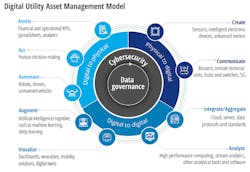Digital Asset Management Strategies Can Address Rising Infrastructure Challenges
Disruptive trends in the power sector can complicate transmission and distribution (T&D) asset management. But a comprehensive digital transformation plan can help asset managers develop data-driven, risk-informed asset management strategies to address these challenges.
Five disruptive trends combine with an expanded, increasingly complex asset mix
T&D asset managers may face increasing challenges as five disruptive trends intensify in the power sector. These include: aging assets, increasingly severe storms and natural disasters, rising cyber and physical threats, mounting public health and electricity demand challenges, and increasing regulatory scrutiny and mandates. At the same time, with the growth of renewables and distributed energy resources (DERs), power providers are managing an expanding number of assets — and those assets are becoming more complex.
These trends could make it more difficult, time-consuming, and costly to manage T&D system assets. And this comes at a time when it may be increasingly critical to understand when to inspect, monitor, repair, replace, or retire assets. Continuing to provide reliable and resilient electricity at an affordable cost may hinge on some of these decisions.
New technologies enable companies to move away from traditional asset management strategies
Before recent technological advances, asset management was compliance-driven, often managed by different departments and sometimes by individual employees maintaining separate reports and systems. These systems may not have been fully connected or consistently updated, and often relied heavily on seasoned employees with knowledge and experience that could be lost as they retired.
Today, digital tools and technologies to manage assets have advanced, including new types of sensors, faster communications and computing technologies, and cognitive capabilities that enable deeper insights and open new ways to realize value from assets. But realizing these benefits through digital transformation requires a comprehensive framework and, like most good journeys, it begins with a map.
Digital Utility Asset Management Model helps map the digital transformation journey
The Digital Utility Asset Management Model is a framework that describes the fundamental journey of digitally transforming and enabling assets (Fig. 1). This journey is backed by supporting technologies, with cybersecurity and data governance at its core. The first step is to identify your company's overarching vision and objectives and then build an integrated solution with a customized roadmap that leads to specific business outcomes.
The physical-digital-physical loop in the Digital Utility Asset Management Model contains nine phases of digital evolution. The journey typically begins at the Create phase but it may not always be linear, and the Act and Assess phases may occur at different points along the way:
- Create: Generate data that capture conditions in the physical world from sensors, cameras, and other intelligent electronic devices monitoring power system assets.
- Communicate: Transmit the data to a central processing system such as the supervisory control and data acquisition (SCADA) system or the enterprise asset management (EAM) system.
- Integrate/Aggregate: Combine the data in a common repository and enable user access and system/application integration; add external data and standardize as required. Data and software may be housed on premises or in the cloud.
- Analyze: Deploy the appropriate tools and processes to harness available data and provide actionable insights.
- Visualize: Use data and analytics to create integrated, real-time dashboards to inform decisions.
- Augment: Use cognitive capabilities, such as machine learning, to analyze current and historical data and predict an asset's future condition and behavior.
- Automate: The augmented behavior technologies advance the process into the digital to physical side of the model where it can enable automated action by robots or other devices.
- Act: Humans use insights provided by the loop to inform decisions about where and when to inspect, monitor, repair, replace, or retire assets. The Act phase may also occur at other points in the loop.
- Assess: Measure benefits and return on investment (ROI) and decide whether to finish a project or revise and refresh the strategy and start around the loop again.
T&D segment is harnessing digital transformation to balance asset cost, risk, performance
Companies in the T&D segment have typically progressed into the Integrate/Aggregate phase of the Digital utility Asset Management Model, though rural utilities may still be in the Communicate phase as they may lack access to high speed communications. Many U.S. utilities have already installed sensors, smart meters, or other intelligent devices across their systems. And some are deploying "sensing aerial solutions" such as drone-mounted cameras to inspect power lines; collect data on the conditions of wires, poles, and transmission towers; and detect potential equipment failures.
One of the biggest challenges has been gathering data from multiple networked asset components and providing a single repository source to monitor and analyze the data. Utilities often lack the cloud and data they generate. In the near term, T&D companies will likely focus further on the Integrate/Aggregate phase and continue progressing into the Analyze and Visualize phases of the model.
In the longer term, utilities are also aiming for the Augment phase in which they'll use artificial intelligence (AI) applications to glean predictive insights that can boost asset performance and save costs. Some are also moving toward real-time video streaming from remote drones for assessing equipment damage and status. This could be especially valuable in the wake of disasters and outages — among the rising challenges T&D companies face today.

